The
Beatless
Sense Mongers
Wood You Save the Trees?

About the Album
The migration of tree species in temperate zones is significantly impacted by climate change through several mechanisms: shifts in suitable habitats, changes in phenology, barriers to movement, soil and ecosystem interactions, competition and predation, and genetic diversity. To save these trees, it is crucial to address climate change.
What Do You Want to Sing About? (Part III)
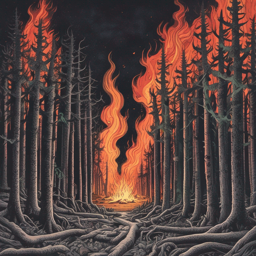
[Verse 2]
What do we want to sing about?
We want to sing, scream, and shout
That Man’s damned demand bout
Is the crime of all time, NO DOUBT!
[Bridge]
We want to sing (sing)
Of how to bring (bring)
Love (love)
A light from above… shine on
Love (love)
Grounded & These Roots Ain’t Made for Walking
Climate change is reshaping the environmental, social, and economic landscapes of temperate zones in the United States, underscoring the need for proactive measures to mitigate its impacts and enhance resilience in affected regions. Regrettably, trees find themselves rooted in their temperate zones, unable to embark on the migratory journeys undertaken by some other species to seek refuge in more hospitable environments.
[Intro, Female Vocal]
Son,
Make sure you stay grounded.
[Break]
Mama!
Plants are in a precarious position. At the hands of Man, vegetation can not escape. There is no way to run. There is no way to hide. After Man conquers, they die. Global warming is caused by an increase in thermal energy in the climate system. The Earth is a climate system. Many subsystems make up our climate. Chaos theory emphasizes the complexity and nonlinearity of dynamic systems, and this complexity is inherent in the interactions between soil, atmosphere, and oceans in the Earth’s climate system.
Nice Set of Lungs
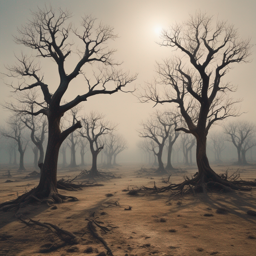
[Intro]
Man does she have a nice set of lungs
So, the swan song’s sung
[Verse 1]
Can’t you see
You’re suffocating me
I can’t breathe
In heat in humidity
I seethe
[Chorus]
For what it’s worth
The lungs of the Earth
Are dying
Are you crying
Or denying
Forests are often referred to as the “lungs of the Earth” because of their critical role in maintaining atmospheric balance and supporting life. Here are the key reasons behind this metaphor:
1. Oxygen Production
- Photosynthesis: Trees and plants absorb carbon dioxide (CO2) from the atmosphere and release oxygen (O2) as a byproduct through the process of photosynthesis. Forests, which cover about 31% of the Earth’s land area, are major contributors to the global oxygen supply.
- Scale of Contribution: Tropical rainforests, such as the Amazon, are particularly significant, producing a substantial amount of the world’s oxygen. However, it’s important to note that marine photosynthesizers like phytoplankton also play a crucial role in global oxygen production .
2. Carbon Sequestration
- Carbon Storage: Forests act as carbon sinks, absorbing more carbon dioxide than they emit. This helps mitigate the effects of climate change by reducing the overall concentration of CO2 in the atmosphere.
- Long-term Storage: Trees store carbon in their biomass (trunks, branches, leaves, and roots) and in forest soils, keeping it out of the atmosphere for extended periods .
3. Air Quality Improvement
- Pollutant Removal: Forests and trees filter air pollutants such as nitrogen oxides, ammonia, sulfur dioxide, and particulate matter, improving air quality and benefiting human health.
- Urban Benefits: In urban areas, trees can significantly reduce pollution levels, making cities healthier places to live .
4. Climate Regulation
- Temperature Moderation: Forests help regulate local and global climates by influencing temperature and humidity. They provide shade and release water vapor through transpiration, which has a cooling effect on the environment.
- Rainfall Patterns: Forests play a crucial role in maintaining the water cycle by contributing to rainfall patterns and stabilizing local and regional climates .
Conclusion
Forests are essential for maintaining the Earth’s ecological balance, much like lungs are vital for human respiration. They produce oxygen, sequester carbon, improve air quality, and regulate climate, making them indispensable to life on Earth.
Sources
Too Much CO2
Trees do absorb carbon dioxide (CO2) from the atmosphere during the process of photosynthesis, where they convert CO2 and sunlight into oxygen and glucose. However, while trees need CO2 to survive, an excess of it in the atmosphere can indirectly harm them in several ways:
1. Climate Change Impacts
- Increased Temperatures: Higher levels of CO2 contribute to global warming. Elevated temperatures can lead to heat stress in trees, disrupting their growth, reproduction, and survival rates .
- Drought Conditions: Climate change driven by excess CO2 can alter precipitation patterns, leading to more frequent and severe droughts. Drought stress can weaken trees, making them more susceptible to disease and pest infestations .
2. Altered Photosynthesis
- Stomatal Closure: Trees may partially close their stomata (tiny openings on leaves) to reduce water loss during hot and dry conditions. This can limit CO2 uptake, slowing down photosynthesis and growth .
- Nutrient Imbalances: Increased CO2 can initially boost photosynthesis, but without corresponding increases in essential nutrients like nitrogen, phosphorus, and potassium, trees may not sustain this enhanced growth, leading to nutrient deficiencies and reduced health .
3. Pests and Diseases
- Weakened Defense Mechanisms: Trees stressed by heat and drought are less able to defend against pests and diseases. Higher temperatures can also expand the range and lifespan of pests like bark beetles, increasing the risk of infestations that can kill trees .
4. Soil and Ecosystem Changes
- Soil Moisture Reduction: Higher temperatures and altered precipitation patterns can reduce soil moisture levels, affecting root health and overall tree vitality .
- Ecosystem Disruption: Climate change can disrupt the balance of ecosystems, affecting not just trees but the entire network of organisms that depend on them, including fungi, insects, and animals. This can lead to a breakdown in symbiotic relationships essential for tree health.
Conclusion
While trees do “breathe” in CO2 and need it for photosynthesis, excessive atmospheric CO2 contributes to climate change, which can lead to conditions that indirectly suffocate and kill trees through heat stress, drought, pest infestations, and nutrient imbalances. The complex interplay of these factors demonstrates the importance of addressing climate change to protect forest health.
I’m Leaving
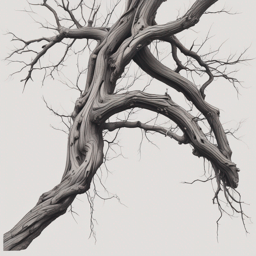
[Intro]
I hate long good-byes
Though…
They’re better than short good-byes
Where everyone dies
(cries and dies)
[Verse 1]
I’m leaving…
Can’t stand here anymore
All my leaves,
Leaving
[Bridge]
Man’s stand’s clear
Ignore the cure
[Chorus]
Stop (Stop!) mass consumption
And, social deception (again and again)
Stop (Stop!) the exploitation
Save (Save!) the population
The arboreal canopy, once lush and verdant, is now undergoing a significant decline. The mature trees, which serve as the keystone species of the forest ecosystem, are increasingly succumbing to anthropogenic pressures. This ecological imbalance has profound repercussions. The reduction in tree density allows invasive vines to proliferate, exploiting the increased sunlight to climb higher and envelop the remaining trees.
Wooden I
[Verse 1]
Wooden I leave(s)
You with an oh! pine
On trees
Such as these
It would appear that there is a complex chaotic system in play that is resulting in the deforestation of the Earth. Following is an abstract from a study started in 2001 and continuing through the present.
Human activities are contributing to tree mortality and deforestation. Humans have also induced climate change in other ways. The combination of human induced climate change and human induced tree mortality are creating a cycle of exponential chain reactions. A better way to say it might be — the veiled causes of the current tree deaths are an unanticipated result of human activities. This new form of deforestation contributes to more global warming. An increase in global warming and human induced climate change intensifies the rate of tree mortalities.
Our climate model uses chaos theory in an attempt to adequately account for humans and forecasts a global average temperature increase of 9 degrees Celsius above pre-industrial levels. Everybody has the responsibility not to pollute. Stop using fossil fuels. Consume less. Love more.
Fossil Fuel’s Fools

[Intro]
Keep your eyes on the hands
They never leave the wrists
Misunderstands
With added twists
[Verse 1]
Wood you save the trees
Please (Oh, please)
As my soul grieves
Please (Oh, please)
[Bridge]
Keep your eyes on the hands
They never leave the wrists
Misunderstands
With added twists
[Chorus]
Fossil fuel’s fools
Corporate tools
Can’t see the trees
(Through the forest’s unrest)
As though there brains seize
[Bridge]
Irate climate primate
Can’t see clearly
At any rate,
Merely
Fossil fuel’s fools
[Verse 2]
Wood you save the trees
Please (Oh, please)
Who possibly disbelieves?
Please (Oh, please)
A SCIENCE NOTE
Giving carbon offsets for planting trees and allowing for the continued use of fossil fuels is greenwashing and accelerates the pace of climate change. This meme is an example. Unfortunately, the meme was created by the oil industry to spread misinformation. Trees are not machines; they are inefficient ‘carbon capture facilities’ and cannot substitute for reducing fossil fuel consumption.
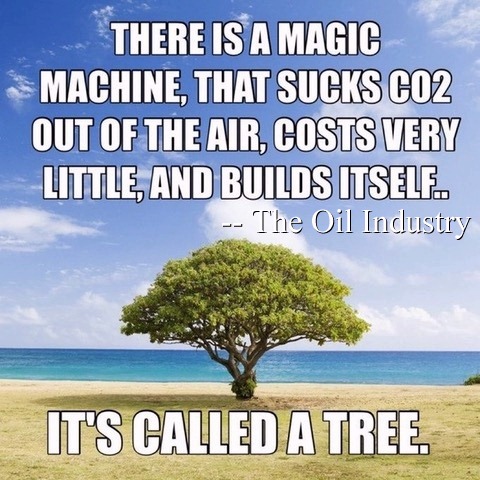 Trees do not permanently sequester carbon. Much of the carbon stored in a tree is in the leaves, which usually last under a year. In one case study, the average life of a tree planted for carbon credit sequestration was 7 years. Additionally, ‘Tree Extinction Due to Human-Induced Environmental Stress‘ is already lowering the life expectancy of all trees. It is extremely rare for a tree to sequester carbon for the approximate 100-year lifespan of carbon in the atmosphere. You cannot burn carbon that has been sequestered for millions of years and expect trees to help in the long run. The important role of trees in climate change is their role as guardians of the soil. In general, climate scientists are against the use of tree sequestration for carbon credits. Giving carbon offsets for planting trees while allowing for the continued use of fossil fuels is greenwashing and accelerates the pace of climate change
Trees do not permanently sequester carbon. Much of the carbon stored in a tree is in the leaves, which usually last under a year. In one case study, the average life of a tree planted for carbon credit sequestration was 7 years. Additionally, ‘Tree Extinction Due to Human-Induced Environmental Stress‘ is already lowering the life expectancy of all trees. It is extremely rare for a tree to sequester carbon for the approximate 100-year lifespan of carbon in the atmosphere. You cannot burn carbon that has been sequestered for millions of years and expect trees to help in the long run. The important role of trees in climate change is their role as guardians of the soil. In general, climate scientists are against the use of tree sequestration for carbon credits. Giving carbon offsets for planting trees while allowing for the continued use of fossil fuels is greenwashing and accelerates the pace of climate change
THE OIL INDUSTRY STRATEGY
The fossil fuel industry uses carbon offsets as a strategy to maintain and even expand the use of fossil fuels while attempting to address concerns about climate change. Here’s how this works:
- Promoting Carbon Offsets: The fossil fuel industry invests in or purchases carbon offsets, which are credits representing reductions in greenhouse gas emissions achieved by others. These offsets can come from various projects such as reforestation, renewable energy, or methane capture.
- Continuing Emissions: By purchasing carbon offsets, fossil fuel companies claim to neutralize their own emissions. This allows them to argue that they can continue extracting, refining, and burning fossil fuels without increasing their net carbon footprint.
- Public Relations: The industry uses carbon offsets as part of their public relations strategy to portray themselves as environmentally responsible. This helps to counter criticism and regulatory pressure related to their contributions to climate change.
- Regulatory Compliance: In some regions, carbon offsets are part of cap-and-trade systems or carbon pricing mechanisms. By using offsets, fossil fuel companies can meet regulatory requirements without reducing their actual fossil fuel production and consumption.
- Delaying Transition: By relying on carbon offsets, the fossil fuel industry can delay transitioning to renewable energy sources. Offsets can be cheaper and less disruptive to their current business models compared to investing heavily in clean energy technologies.
- Economic Benefits: Investing in carbon offset projects can also bring economic benefits to fossil fuel companies. For instance, they might invest in projects that align with their other business interests or use offsets to enter new markets.
The fossil fuel industry uses carbon offsets to give the appearance of reducing their environmental impact while continuing to produce and use fossil fuels. This approach helps them meet regulatory requirements, maintain public support, and delay the transition to a low-carbon economy.
THE REAL PROBLEM
The exact amount of O2 contributed and CO2 absorbed is a complicated equation on a daily or yearly basis. Trees both absorb and emit CO2. However, this calculation is relatively meaningless because CO2 has an average lifespan in the atmosphere of 100 years. In contrast, 99% of a tree’s carbon has an average cycle of 7 years. Essentially, 0% of the CO2 causing climate change is stored in a tree. The importance of trees and forests lies in their role within the soil ecosystem. Trees act as caretakers for the CO2 stored in the soil.
CANADIAN WILDFIRE CASE STUDY
For a frightening example, look at the forest fires in Canada. These fires are more intense and frequent due to human CO2 emissions. Last year, Canada’s largest contributor to CO2 emissions was wildfires. While this may not be a significant factor in the long term, as that CO2 would have returned to the atmosphere within 50 years anyway, it creates a feedback loop that accelerates climate change.
But it gets worse. The real feedback loop problem is the permafrost. Forest fires and a warming climate have ignited the permafrost, causing ‘zombie fires’ that burned all winter under the snow and continue to burn this year. Millions of years of CO2 are stored in the permafrost. While we do not know exactly how much carbon is stored in nature, it is reasonable to assume that temperatures could be pushed from 3 degrees to 6 degrees above pre-industrial levels. Humans cannot thrive above a rise of 1.5 degrees. Much of the Earth will be uninhabitable if the temperature rises an additional 6 degrees Celsius. If humans also add 3 degrees Celsius, the temperature and humidity will approach a wet-bulb temperature that will not sustain human life.
Axeman
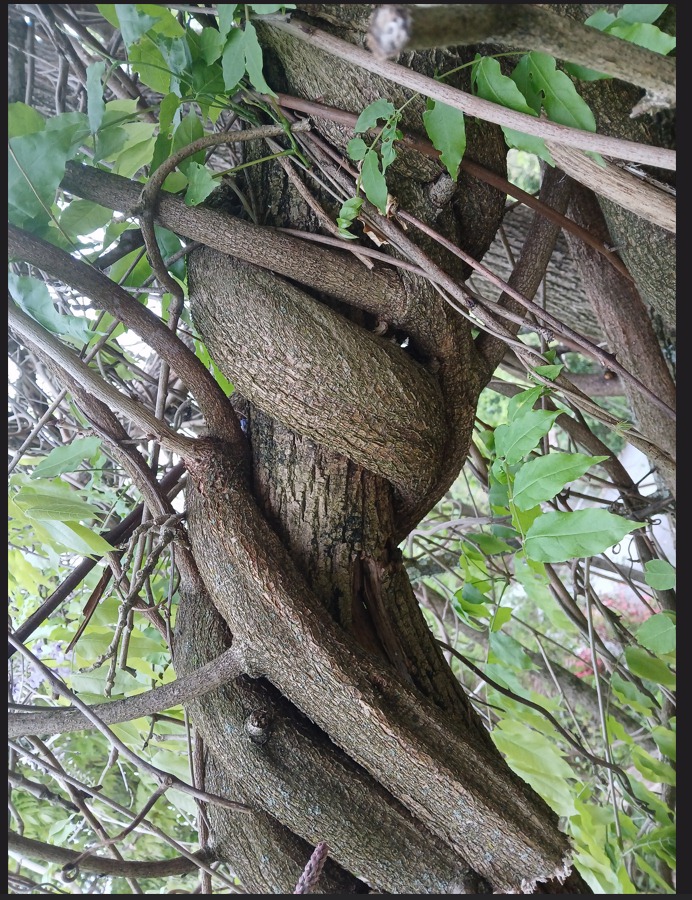
Timber!
[Verse 1]
Man came with axe in hand
Didn’t seem to understand
A stand of trees like these
Overcome by Man’s disease
[Break]
Timber!
[Chorus]
Timber! Makes a spine shiver
All to supply and deliver
To the primate climate machine
There goes the dream…
The Decline of Penn's Sylvania
Pennsylvania derives its name from the land grant bestowed upon William Penn. Penn’s grant, known as “sylvania,” translates to “forest” in Latin. Prior to the arrival of European settlers, the region was predominantly covered by vast expanses of dense forests, with a wide range of biodiversity and inhabited by indigenous peoples who relied on the land for sustenance and cultural practices.
In the 17th and 18th centuries, European settlers began to clear land for agriculture and settlement, leading to widespread deforestation in Pennsylvania. The demand for timber and wood products grew rapidly as the population expanded and industries such as shipbuilding, construction, and manufacturing developed. Logging became a prominent economic activity in Pennsylvania, with vast quantities of timber harvested. By the 19th century, Pennsylvania had become one of the leading timber-producing states in the United States, with extensive logging operations throughout the region. The emergence of the lumber industry brought prosperity to many communities but also led to widespread environmental degradation, including soil erosion, loss of biodiversity, and disruption of watershed systems.
As concerns grew over the sustainability of logging practices and the conservation of natural resources, efforts were made to regulate and manage forest resources more effectively. In the late 19th and early 20th centuries, the conservation movement gained momentum, leading to the establishment of state and federal agencies tasked with overseeing forestry and conservation efforts.
A Troubling Decline
In Pennsylvania, the once lush and verdant tree canopy is now facing a troubling decline, as the old growth trees succumb to the relentless pressures of human activities. The consequences of this ecological imbalance reverberate through the forest, as vines empowered by the thinning canopy are able to reach higher.
As these vines ascend to new heights, they cover and kill the venerable trees below. The intricate balance of nature is disrupted, as the loss of the old growth trees impacts biodiversity, soil stability, and wildlife habitats.
The gradual encroachment of vines into the upper reaches of the forest canopy represents a poignant symbol of the broader environmental challenges facing Pennsylvania and beyond. It serves as a stark reminder of the interconnectedness of all living beings and the urgent need for stewardship and conservation to preserve the natural wonders that enrich our lives.
Overall, climate change is reshaping the environmental, social, and economic landscapes of temperate zones in the United States, underscoring the need for proactive measures to mitigate its impacts and enhance resilience in affected regions. Regrettably, trees find themselves rooted in their temperate zones, unable to embark on the migratory journeys undertaken by some other species to seek refuge in more hospitable environments.
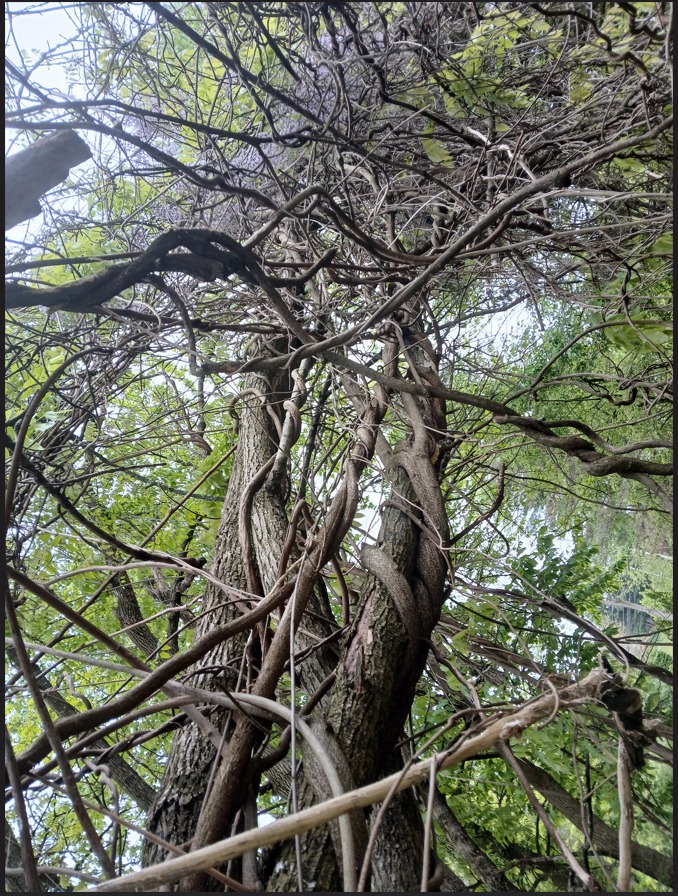
Heard It Through the Vine & Full Sun
In Pennsylvania, the arboreal canopy, once lush and verdant, is now undergoing a significant decline. The mature trees, which serve as the keystone species of the forest ecosystem, are increasingly succumbing to anthropogenic pressures. This ecological imbalance has profound repercussions. The reduction in tree density allows invasive vines to proliferate, exploiting the increased sunlight to climb higher and envelop the remaining trees.
As these vines ascend, they create a parasitic relationship with the trees, ultimately leading to their asphyxiation. This phenomenon disrupts the ecological equilibrium, diminishing biodiversity, destabilizing soil, and adversely affecting wildlife habitats.
The encroachment of vines into the upper canopy serves as an indicator of broader environmental challenges. This scenario underscores the interconnectedness of ecosystems and highlights the urgency for proactive conservation and sustainable management practices to preserve these vital natural resources.
Reforestation efforts face challenges due to shifting temperate zones. As observed in Canada, where wildfires have devastated old-growth forests, replanting the same species may not be effective if climatic conditions have altered significantly, potentially preventing the new trees from reaching maturity. Thus, adaptive management strategies that consider future climatic scenarios are essential for effective reforestation.
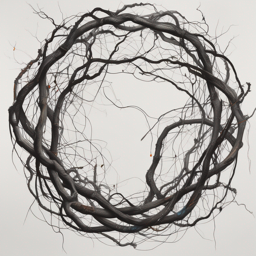
Climate change is significantly impacting the temperate zones in the United States in several ways:
- Shifts in Temperature: Temperate zones are experiencing changes in temperature patterns, with increases in both average temperatures and the frequency of extreme heat events. Winters are becoming milder, and summers are growing hotter, leading to shifts in growing seasons and ecosystem dynamics.
- Altered Precipitation Patterns: Climate change is causing alterations in precipitation patterns, including changes in rainfall intensity, frequency, and distribution. Some regions within temperate zones may experience more frequent and intense rainfall events, leading to increased flooding and soil erosion, while others may face more prolonged periods of drought, impacting water resources and agriculture.
- Changes in Ecosystems: The distribution and composition of ecosystems within temperate zones are being disrupted by climate change. Species ranges are shifting, and migration patterns are changing as plants and animals respond to altered temperature and precipitation conditions. This can lead to mismatches in timing between species interactions, such as flowering and pollination, or disruptions in food webs.
- Impacts on Agriculture: Climate change is posing challenges to agriculture in temperate zones, affecting crop yields, pest and disease dynamics, and the availability of suitable growing conditions. Heat stress, drought, and extreme weather events can damage crops and reduce agricultural productivity, impacting food security and economic livelihoods.
- Increased Risk of Wildfires: Warmer temperatures and drier conditions are contributing to an increased risk of wildfires in temperate zones, particularly in regions with dense vegetation and susceptible to drought. Wildfires can have devastating consequences for ecosystems, communities, and air quality, posing risks to human health and safety.
- Threats to Human Health: Climate change in temperate zones can exacerbate health risks associated with extreme heat events, air pollution, and the spread of vector-borne diseases. Vulnerable populations, such as the elderly, children, and individuals with pre-existing health conditions, may face increased risks of heat-related illnesses and respiratory problems.
Overall, climate change is reshaping the environmental, social, and economic landscapes of temperate zones in the United States, underscoring the need for proactive measures to mitigate its impacts and enhance resilience in affected regions.
Head North

[Intro]
“Head North, you nut”
But, but, but
[Verse 1]
Rooted in tradition
Of the Southern ways
Starting my migration
During the final days
[Bridge]
Temperature increases
As species decreases
Trees “move” through a process of gradual migration, which occurs over generations through the dispersal of seeds. This migration is driven by environmental changes, such as climate change, and can be observed in the expansion of greenery into new areas, such as the tundra, and the invasion of southern species into regions like the Mid-Atlantic USA. Here's how these processes work:
Expansion into the Tundra
In Arctic and sub-Arctic regions, warming temperatures have led to the expansion of tree lines into previously barren tundra areas. This process involves several steps:
- Seed Dispersal: Trees like spruce and birch produce seeds that are dispersed by wind, animals, or water. As temperatures rise, seeds can survive and germinate in areas further north where they previously could not.
- Seedling Establishment: Once seeds land in a suitable area, they must germinate and grow. Warmer temperatures and a longer growing season improve the chances for seedlings to establish.
- Growth and Maturation: As seedlings grow, they gradually form new tree stands, expanding the forested area northward. This process is slow but cumulative, leading to noticeable changes over decades.
- Ecosystem Changes: The establishment of trees in the tundra brings changes to the local ecosystem. Trees provide shade, alter soil composition, and affect the local microclimate, making it more suitable for additional plant and animal species.
Studies and observations have documented this greening effect in regions like Alaska and Siberia, where satellite imagery shows an increase in vegetation cover in the tundra over recent decades.p>
Invasion of Southern Species in the Mid-Atlantic USA
In the Mid-Atlantic USA, climate change has facilitated the northward movement of species traditionally found in more southern regions. This invasion is marked by several factors:
- Temperature Increase: Warmer temperatures allow species that thrive in warmer climates to survive and reproduce in more northern areas.
- Seed Dispersal Mechanisms: Southern species, such as the loblolly pine or the southern pine beetle, spread through natural dispersal mechanisms. Birds, wind, and animals carry seeds northward.
- Competitive Advantage: These southern species often have competitive advantages in warmer conditions, allowing them to outcompete native species. For example, the southern pine beetle has expanded its range northward, affecting forests in New Jersey and Pennsylvania.
- Changes in Phenology: Warmer temperatures can change the timing of life cycle events. For example, earlier springs can favor the growth of southern species over native species, giving them a head start in the growing season.
Research has shown that the ranges of many tree species are shifting northward in response to climate change. For instance, the U.S. Forest Service has observed that species like the sweetgum and the live oak are becoming more common in areas where they were previously rare or absent.
Sources
These examples illustrate how trees migrate by gradually expanding their range into new areas as environmental conditions change, driven by factors such as temperature increases, changes in precipitation patterns, and altered ecosystems.
Invasive Tree Species in North America
Several southern tree species have migrated northward in North America due to the impacts of climate change. Here are some notable examples:
Loblolly Pine (Pinus taeda), Southern Magnolia (Magnolia grandiflora), Sweetgum (Liquidambar styraciflua), American Holly (Ilex opaca), Live Oak (Quercus virginiana).
Migration Mechanisms
- Warmer Temperatures: As global temperatures rise, the climates of northern regions become more suitable for these southern species.
- Changing Precipitation Patterns: Altered rainfall patterns can create conditions more favorable to southern species in northern areas.
- Extended Growing Seasons: Longer growing seasons in northern regions due to climate change allow southern species more time to establish and grow.
Ecological Implications
- Competition with Native Species: The migration of southern species can lead to increased competition with native northern species, potentially altering local ecosystems.
- Biodiversity Changes: The influx of new species can change the composition of forests, affecting biodiversity and ecosystem services.
These examples illustrate the dynamic nature of forest ecosystems in response to climate change, with southern tree species moving into new territories as they seek suitable habitats.
Dense Woulds
[Intro]
Dense woulds
(Could’s, should’s)
Can’t see the forest through the trees
Oh, please
Can’t see the trees through the forest
Unless…
[Verse 1]
Do we understand
The situation is large
Can we comprehend
When Man is in charge
Dead in the Middle?
[Intro]
(knock, knock}
Knock on would
[Instrumental, Guitar, Drum Fills]
[Verse 1]
So, here’s a riddle
Are you dead in the middle
In most mature trees, the inner part of the tree, known as the heartwood, is dead, while the outer layers, including the sapwood, cambium, and bark, are alive. Here's a detailed explanation of these different parts of a tree and their functions:
Parts of a Tree
- Heartwood:
- Location: The central, innermost part of the tree.
- Characteristics: Composed of older, dead xylem cells. It is typically darker in color and denser than the outer layers.
- Function: Provides structural support to the tree. Even though it is dead, it plays a crucial role in maintaining the tree's stability.
- Sapwood:
- Location: Surrounding the heartwood, just inside the cambium layer.
- Characteristics: Made up of younger xylem cells that are still alive. It is lighter in color compared to the heartwood.
- Function: Conducts water and nutrients from the roots to the rest of the tree. The sapwood is essential for the tree’s growth and survival.
- Cambium:
- Location: A thin layer of living cells between the sapwood and the inner bark.
- Characteristics: It is a very narrow layer but crucial for growth.
- Function: Produces new xylem cells (which become part of the sapwood) and new phloem cells (which become part of the inner bark). This layer is responsible for the tree's secondary growth, increasing the tree's girth.
- Phloem (Inner Bark):
- Location: Just outside the cambium layer, beneath the outer bark.
- Characteristics: Composed of living cells that transport nutrients produced by photosynthesis (mainly sugars) from the leaves to the rest of the tree.
- Function: Essential for distributing the energy necessary for growth and maintenance of the tree.
- Outer Bark:
- Location: The outermost layer of the tree.
- Characteristics: Made up of dead cells that provide protection.
- Function: Shields the tree from physical damage, disease, and extreme weather conditions.
Understanding Tree Growth
- Growth Rings: Each year, the cambium produces new layers of xylem (adding to the sapwood) and phloem. Over time, the inner layers of sapwood become heartwood as they die and are filled with resins and other substances that make them more rigid and resistant to decay.
- Active Growth Areas: Only the cambium, phloem, and the outermost layers of sapwood are involved in the active growth and nutrient transport processes. The heartwood, although dead, provides crucial structural support to the tree.
In summary, while the central heartwood of a mature tree is dead and provides structural support, the outer layers, including the sapwood, cambium, and phloem, are alive and perform vital functions necessary for the tree's growth and survival.
Rings True
Tree rings, also known as growth rings, are formed by the annual growth of trees. Each ring typically represents one year of growth, and they are a result of the tree’s response to seasonal changes in climate. Here’s a detailed explanation of how they are formed:
Structure of Tree Rings
- Spring (Earlywood) Growth:
- In the spring, conditions are usually favorable for growth with plenty of water and nutrients.
- The tree grows rapidly, producing large, thin-walled cells known as earlywood (or springwood). These cells have a larger diameter and are lighter in color.
- This rapid growth allows for efficient transport of water and nutrients.
- Summer (Latewood) Growth:
- As the season progresses into summer and sometimes early autumn, growth slows down due to less favorable conditions, such as reduced water availability.
- The tree produces smaller, thicker-walled cells called latewood (or summerwood). These cells are denser and darker in color.
- Latewood adds strength to the tree.
- Dormancy:
- During winter, growth typically stops due to low temperatures and dormancy sets in. No new cells are produced during this period.
Formation Process
- Annual Cycle: This cycle of producing earlywood in the spring and latewood in the summer creates a distinct boundary between the two types of wood. The contrast between the lighter earlywood and the darker latewood forms a visible ring.
- Environmental Influence: The width and characteristics of each ring can be influenced by environmental conditions. Favorable growing conditions (adequate water, nutrients, and favorable temperatures) will result in wider rings, while poor conditions (drought, lack of nutrients, extreme temperatures) will result in narrower rings.
- Historical Record: The pattern of tree rings can be used to study past climatic conditions, a field known as dendrochronology. By analyzing tree rings, scientists can infer historical climate patterns, such as periods of drought or unusually wet years.
Special Cases
- False Rings: Sometimes, a tree can produce what appears to be multiple rings in a single year due to unusual weather conditions. These are known as false rings.
- Tropical Trees: In tropical regions where there is less variation in seasons, trees may not produce distinct annual rings. Growth rings in these trees can be influenced by other factors such as changes in rainfall patterns.
Tree rings are formed by the seasonal variation in growth conditions, with distinct layers of earlywood and latewood created each year. These rings provide valuable information about the tree’s age and the environmental conditions it has experienced throughout its life.
Seen Sawn (Can’t Cant)
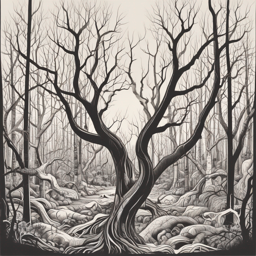
I’ve seen the sawn
I can’t cant
[verse 1]
The maple spoke to the oak:
“Seems ample here,
would we fear?” (Wood, we fear)
The evergreen considered the scene:
“Opine, the end is near” (pins and needles)
[Chorus]
(Knot now)
Not in the time of Man
Don’t think we can
No know-how
(Knot now)
Not in the spine of Man
[Bridge]
I’ve seen the sawn
I can’t cant
[Instrumental, Woodblock, Drum Fills, Guitar Solo]
[verse 2]
Asked the oak:
“We’re going to croak?
Maple, aren’t the woulds ample?”
The evergreen pondered the scene:
“Opine, the end of our dream” (pins and need-les)
[Chorus]
(Knot now)
Not in the time of Man
Don’t think we can
No know-how
(Knot now)
Not in the spine of Man
[Bridge]
I’ve seen the sawn
I can’t cant
SCIENCE NOTES
A cant is a partially processed log, typically a large slab, that is sawn and sent to another machine for additional processing or sold for use as a building log. A cant sawmill specializes in the initial sawing of logs to create cants, which are then used for further manufacturing or construction purposes. The head saw, a key piece of machinery in this process, is responsible for the initial conversion of logs into cants. This machine is designed to make the primary cuts that transform raw logs into more manageable and uniform pieces, facilitating subsequent processing steps.
This song uses clever wordplay and metaphor to discuss deforestation and climate change. Here’s an interpretation of its lyrics:
[Intro]
“I’ve seen the sawn I can’t cant”
The speaker, a tree, has witnessed the cutting down of trees (“sawn”) and feels threatened. She can’t cant. A cant is a partially processed log.
[Verse 1]
“The maple spoke to the oak: ‘Seems ample here, would we fear?’ (Wood, we fear) The evergreen considered the scene: ‘Opine, the end is near’ (pins and needles)”
The conversation among the trees personifies them, giving them voices to express concerns about their survival. “Wood, we fear” is a play on words (“would we fear”), highlighting their anxiety about being cut down. The evergreen's observation, “Opine, the end is near,” suggests a bleak outlook for the forest, evoking “pins and needles” as a metaphor for a tense, precarious situation.
[Chorus]
“(Knot now) Not in the time of Man Don’t think we can No know-how (Knot now) Not in the spine of Man”
The chorus plays with the homophones “knot” and “not.” “Knot now” indicates that the complex, intertwined issues of deforestation and climate change are not being addressed. “Not in the time of Man” suggests that humanity is failing to act within the necessary timeframe. “No know-how” implies a lack of knowledge or will to address these problems effectively. “Not in the spine of Man” implies a lack of courage or backbone in addressing these issues.
[Verse 2]
“Asked the oak: ‘We’re going to croak? Maple, aren’t the woulds ample?’ The evergreen pondered the scene: ‘Opine, the end of our dream’ (pins and need-les)”
The oak’s question “We’re going to croak?” directly addresses the threat of death facing the trees. “Aren’t the woulds ample?” (a play on “woods” and “woulds”) reflects a denial or hope that there's still enough forest to survive, as well as suggest there are not enough “people that would help.” The evergreen's response, “the end of our dream,” acknowledges the inevitable destruction, again playing on “pins and needles” to convey the fragility of their existence. The evergreen, a pine tree, also serves as wordplay with “opine” and pine “needles”. The use of “need-les” is double wordplay by the pine as she is making a commentary on the tendency for humans to be so needy, or a bunch of need-les.
The song uses wordplay and metaphors involving trees and woodworking to highlight the issues of deforestation and climate change. The trees personify nature’s plight, expressing fear and resignation. The chorus criticizes humanity’s failure to act, lacking the knowledge, courage, and urgency required to address these environmental crises. The repetition of the bridge underscores the speaker’s frustration and sense of helplessness.
Oh, To….
[Intro]
(Oh,)
O2
Oh, to….
[Verse 1]
The oxygen is blowing
Through the trees
Blowing…
Blowing over to me
[Bridge]
The atmosphere
Brought near
In the breeze
Thank you
For the please
[Chorus]
The way that O2 is going
Respiration starts slowing
OH, to
Breathe with ease
Loving living
In the tree’s breeze
How Oxygen from Trees Reaches You in a Breeze
Trees produce oxygen through the process of photosynthesis, where they convert carbon dioxide and water into glucose and oxygen using sunlight. This oxygen is released into the atmosphere through tiny pores on the leaves called stomata. Here’s a detailed explanation of how the oxygen from trees reaches you and its health benefits:
Process of Oxygen Release and Distribution
- Photosynthesis:
- Chemical Reaction: Trees take in carbon dioxide (CO2) and water (H2O) and, using sunlight, convert these into glucose (C6H1 2O6) and oxygen (O2).
- Oxygen Release:
- Stomata: The oxygen produced during photosynthesis is released into the air through stomata. These tiny openings are primarily on the underside of leaves and allow gases to move in and out.
- Distribution by Wind:
- Air Movement: Once released, the oxygen molecules diffuse into the surrounding air. Wind and breezes help to disperse these oxygen molecules over a larger area, mixing with the atmosphere.
- Breathing in Oxygen:
- Inhalation: When you breathe, you take in air from the atmosphere, which contains a mixture of gases, including oxygen. The oxygen molecules enter your respiratory system and are transported to your cells via your bloodstream.
Health Benefits of Oxygen from Trees
- Improved Air Quality:
- Pollution Reduction: Trees not only produce oxygen but also absorb pollutants like sulfur dioxide, ammonia, and nitrogen oxides, improving the overall air quality.
- Physical Health:
- Respiratory Health: Breathing cleaner air with higher oxygen levels can improve lung function and reduce respiratory problems.
- Immune System Boost: Higher oxygen levels can enhance the immune system, making it more effective in fighting infections.
- Mental Health and Wellness:
- Stress Reduction: Exposure to natural environments and fresh air can reduce stress levels, lower blood pressure, and improve overall mental well-being.
- Enhanced Mood: Being in nature and breathing in fresh air rich in oxygen can improve mood and cognitive function.
Conclusion
The oxygen produced by trees is essential for life, contributing significantly to the air we breathe. Wind and breezes help distribute this oxygen, ensuring that it mixes well with the atmosphere and reaches us efficiently. The benefits of this oxygen extend beyond just sustaining life, contributing to better physical and mental health by improving air quality and providing a calming, stress-reducing environment.
Phytoncides

[Intro]
Phytoncides
We’re fightin’ on the same side
[Verse 1]
I see some new growth
And it’s growing on
The greener of both
When shown upon
The oils in the air from conifers, known as phytoncides, have numerous health benefits that make forest bathing (Shinrin-yoku) particularly effective. Here’s why these oils are beneficial for health and the biome:
Benefits of Conifer Oils in Forest Bathing
- Boosting Immune Function:
- Phytoncides: These are antimicrobial volatile organic compounds emitted by trees. Studies have shown that exposure to phytoncides can increase the activity of natural killer (NK) cells, which play a crucial role in the immune system by attacking virus-infected cells and tumors .
- Reducing Stress and Improving Mood:
- Stress Reduction: Phytoncides have been found to reduce levels of stress hormones like cortisol. Time spent in forests, inhaling these compounds, can lead to lower stress levels and improved mood .
- Mental Health: Forest bathing has been linked to reduced anxiety, depression, and fatigue. The calming effect of phytoncides on the nervous system can enhance overall mental well-being .
- Anti-Inflammatory and Antioxidant Effects:
- Inflammation: Phytoncides possess anti-inflammatory properties, which can help reduce inflammation in the body. This is particularly beneficial for people with chronic inflammatory conditions .
- Antioxidants: The antioxidant properties of phytoncides help protect the body from oxidative stress, which is linked to various chronic diseases and aging .
- Improving Cardiovascular Health:
- Heart Health: Exposure to forest environments and phytoncides can lower blood pressure and heart rate, contributing to better cardiovascular health .
- Enhancing Respiratory Function:
- Breathing Easier: The clean, oxygen-rich air in forests, combined with the antimicrobial properties of phytoncides, can improve respiratory function and overall lung health .
Impact on the Biome
- Microbiome Diversity: The diversity of microbes in forest environments can positively influence the human microbiome, enhancing immune function and overall health .
- Environmental Health: Conifer forests play a vital role in maintaining ecological balance. The antimicrobial properties of phytoncides also help in controlling pathogen populations, contributing to the health of the forest biome .
Climax and Succession

[Intro]
Climax and succession
Spiraling depression
[Verse 1]
In a rift
Species shift
Disturbance regime
Do you know what I mean
[Chorus]
Biodiversity
Becomes a rarity
Obviously
We can not see
[Bridge]
Blind to our demise
No surprise?
Climate change has profound effects on both climax and succession forests, altering their composition, structure, and ecological dynamics. Here's how these impacts unfold:
Climax Forests
Climax forests are stable, mature ecosystems that have reached a late stage of ecological succession. They are characterized by a stable species composition and structure that persists until disrupted by a disturbance. Climate change impacts these forests in several ways:
- Temperature Increases: Warmer temperatures can stress species that are adapted to cooler climates, leading to shifts in species composition. For example, in boreal climax forests, species like spruce and fir may decline, while more temperate species like maple and oak may increase .
- Altered Precipitation Patterns: Changes in precipitation can affect soil moisture levels, influencing tree growth and survival. In areas experiencing increased drought, such as some temperate and Mediterranean forests, species that are less drought-tolerant may decline, altering the forest structure and function .
- Increased Frequency of Disturbances: Climate change can lead to more frequent and intense disturbances, such as wildfires, storms, and pest outbreaks. These disturbances can reset succession processes, pushing climax forests back to earlier successional stages and altering their long-term stability .
- Pest and Disease Proliferation: Warmer temperatures can facilitate the spread of pests and diseases. For instance, the mountain pine beetle has devastated large areas of climax forests in North America, leading to widespread tree mortality and changes in forest composition .
Succession Forests
Succession forests are in various stages of recovery following a disturbance. Climate change affects these forests by altering the rates and trajectories of succession:
- Altered Growth Rates: Changes in temperature and CO2 levels can influence the growth rates of different species. Some pioneer species may grow faster under higher CO2 concentrations, potentially accelerating early successional stages but also potentially leading to different competitive dynamics later on .
- Species Shifts: Climate change can influence which species dominate during different successional stages. For example, increased temperatures and altered moisture regimes can favor different sets of pioneer and mid-successional species, leading to novel successional pathways .
- Disturbance Regimes: More frequent disturbances can prevent succession forests from reaching climax stages, maintaining them in earlier stages of succession for longer periods. This can alter the landscape mosaic and the biodiversity it supports .
- Seed Dispersal and Establishment: Climate change can affect seed dispersal mechanisms and the establishment success of seedlings. Changes in wind patterns, animal behaviors, and soil conditions can influence which species successfully establish in succession forests .
Ecological and Management Implications
- Biodiversity: Changes in species composition and structure can affect biodiversity at multiple levels. Some species may thrive while others decline, potentially leading to losses in overall biodiversity.
- Ecosystem Services: The ability of forests to provide ecosystem services, such as carbon sequestration, water regulation, and habitat provision, can be altered. For example, changes in species composition can influence the carbon storage capacity of forests.
- Conservation and Management: Adaptive management strategies are needed to address the impacts of climate change on both climax and succession forests. This includes monitoring changes, facilitating species migration, and managing disturbances to maintain forest health and resilience.
What Do You Want to Sing About? (Part I)
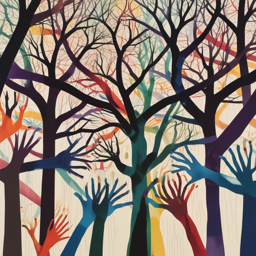
[Intro]
What do you want to sing about?
Something that makes you scream…
And shout?
[Verse 1]
What do you want to sing about
Something that makes you scream and shout
What makes you feel to deal with reality
And, turn wrong about?
[Bridge]
We want to sing (sing)
Of how to bring (bring)
Love (love)
A light from above… shine on
Love (love)
The migration of tree species in temperate zones is significantly impacted by climate change through several mechanisms:
- Shifts in Suitable Habitats: As temperatures rise, the suitable habitats for many tree species are moving poleward and to higher elevations. Trees that thrive in cooler climates are finding their current habitats increasingly inhospitable, pushing them to migrate towards cooler areas. However, the speed of climate change often outpaces the natural migration capabilities of many tree species, leading to potential mismatches between trees and their optimal environments.
- Changes in Phenology: Climate change alters the timing of biological events such as leaf-out, flowering, and seed dispersal. These changes can affect the success of tree species in establishing themselves in new areas. For instance, if spring arrives earlier, trees that cannot adjust their growth cycles might struggle to compete with species that can, impacting their ability to migrate successfully.
- Barrier to Movement: Physical barriers such as mountains, rivers, and human-made structures like roads and urban areas can impede the migration of tree species. Even without these barriers, the fragmented nature of modern landscapes often means that contiguous suitable habitats are rare, complicating the migration process.
- Soil and Ecosystem Interactions: Tree species are part of complex ecosystems and their successful migration depends on the migration of associated species like soil microbes, fungi (mycorrhizae), and pollinators. If these organisms do not migrate at the same rate or to the same new areas, tree species may struggle to establish in new habitats.
- Competition and Predation: As tree species migrate, they encounter new competitors and predators. These interactions can affect their ability to establish and thrive in new areas. For example, a migrating tree species might be less competitive in its new habitat or might face predation from herbivores that it did not encounter in its original range.
- Genetic Diversity: The genetic diversity of tree populations affects their ability to adapt to new conditions. Populations with high genetic diversity are more likely to have individuals that can survive and reproduce in changing conditions. However, many tree species have low rates of natural genetic mutation and long lifespans, which can slow their adaptive responses to rapid climate changes.
Examples and Studies
- North American Forests: In North America, studies have shown that tree species such as sugar maple and American beech are migrating northward as temperatures increase. However, this migration is often slower than needed to keep pace with climate change predictions.
- European Forests: European beech and Norway spruce are also showing signs of northward migration and moving to higher elevations in response to warming climates.
- Modeling and Predictions: Various climate models predict significant shifts in tree species distributions. For instance, a study using the Species Distribution Model (SDM) predicts that suitable habitats for many European tree species will shift northwards and upwards by several hundred kilometers over the next century.
SCIENCE NOTES
 Soil Degradation and Desertification
Soil Degradation and Desertification
Carbon Offsets and Sequestration: Planting Trees is Greenwashing
Create a sustainable and climate-resilient environment in and around your home and prevent soil degradation.
Protect Your Home: Violent Rain and Stormwater Runoff
Climate Change: What Can I Do?
Created by: BROUSE
All text, sights, sounds, performances, etc. © 2024















 Soil Degradation and Desertification
Soil Degradation and Desertification